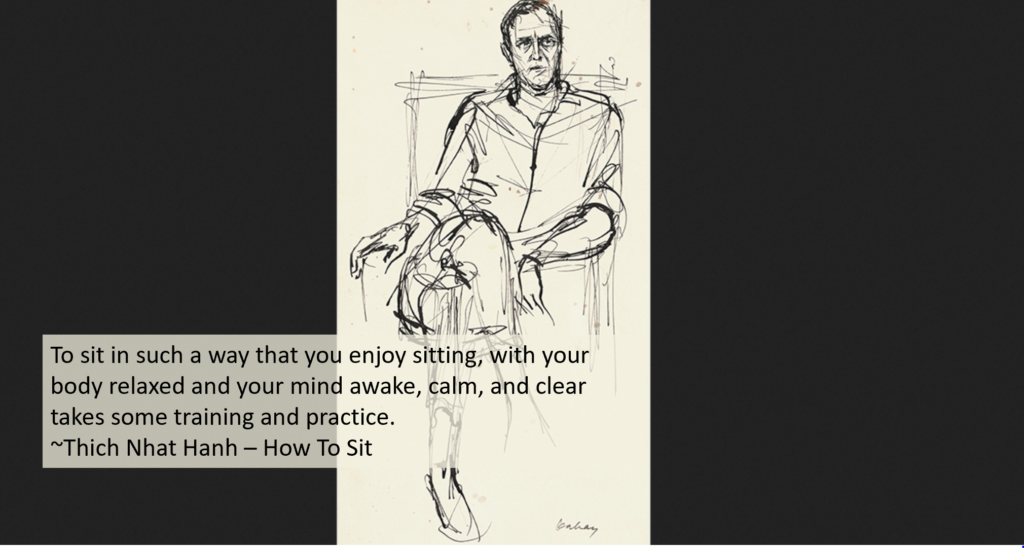
When I start a new beginners class, the first lesson is “How To Stand”. I imagine some feel they know quite well how to stand, and I am sure some do. Many do not. That is, they do not know how to stand without tension, relaxing all the muscles which are not needed to remain standing. They do not know when their bodies are most aligned with gravity and when they fight against it – overtaxing their knees and hips and backs and shoulders and neck.
Our minds are often elsewhere and do not know how well or how poorly the body is sustaining its relationship with gravity. As gravity is ever-present, we grow to ignore its demands on our physical being. We form habits of standing shifted, and the abnormal (dare I say… aggressive) stance against gravity becomes a habit and begins to feel normal. Fighting gravity makes us weak. It takes training and practice to re-align our bodies so that gravity will give us strength instead of weakening us.
Tai chi and qigong practices usually include some Wuji training. In Cradle Style, we refer to it as the “Center Stance” because it is an opportunity to locate and feel your center – that place where gravity is friend rather than foe. It is not a fighting stance like “Bow Stance” and it is not a strengthening stance like “Horse Stance”. It is a place to begin. From Center Stance movement is released.
The concept of Wuji differs somewhat from the idea of centering. It originates from Taoist philosophy. If you consider the Yin/Yang symbol (in Chinese thought, it is the Taiji symbol) you can see the black and the white circling around each other in a dance. The black is not fully black and the white not fully white. They are in relationship to one another and yet not fully distinct from each other. Now imagine the circle which contains this magnificent flow of elements… that surrounding circle is the “Wuji”. It is the unmoving thing which provides the space for movement. It is the void which allows itself to be filled. It is the place of beginning.
The Wuji Stance is simple enough. Stand with feet hip-distance apart. By hip-distance, I do not mean look at your hips and estimate their width – I mean allow your hips to physically determine the distance. To perform this, unlock your knees and sink slightly into a comfortable mini-squat. Then shift all of your weight onto one leg, making the other completely empty. Lightly touch the heel of the empty leg to the ground as far out in front of you without shifting any weight. Keeping the empty leg empty, swing it out and around until parallel with your full leg. Where the foot of the empty leg fully connects with the ground yet as far away from the full leg as possible is the measure of the distance your hips will allow.
If this presents any physical pain whatsoever, shorten the distance to less than hip-width. There is no benefit to pain in tai chi – but there is benefit to knowing where pain resides – but that I shall save for another time.
Your feet should be in full contact with the ground. Think of the bottom of your foot as a tripod of sorts – one point of contact in your heel and two points of contact in the ball and the outside ball of your foot. It is not necessary initially to feel your weight equally distributed over these three points – but you should feel they are all in solid contact with the ground. There is much to discuss about the feet and the ground they stand upon, but for now the most important thing to train and practice is awareness of the feeling between them.
Take a moment where you are, feet pointing forward, distanced by your hips, knees unlocked and just slightly bent. Try to sense gravity here. Do you feel it pulling you forward? Backwards? Do you have one shoulder raised higher than the other? or is your head heavier than it needs to be? With just a solid placement of the feet, knees and hips and the goal of feeling aligned with gravity, you should be able, if slowly, to intuit the rest of the Wuji stance.
Some teachers will teach about “tucking the tailbone” or “dropping the tail”. I’ve heard the example of imagining your pelvis as a bowl filled with precious liquid. The one I like most is to imagine sitting on a slight window ledge. For many, these teachings may work perfectly but for others, they may have such a different normal that such advice creates tension rather than releases it – and to be clear – the Center Stance must release tension to be helpful. Try experimenting with the hips instead – shift them forward and back, slowly, avoiding any tightness or pain. Try to feel where your body has the most strength while relaxed.
Hey You!
As an assigned exercise, spend a few minutes today, either sitting or standing. Try to focus your mind on releasing tension in your body as much as you can without falling over. “Explore gravity!” as I like to say in class.